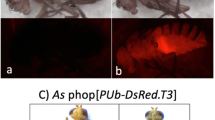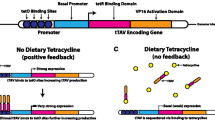Summary
The frequency of P element excision and the structure of the resulting excision products were determined in three drosophilid species, Drosophila melanogaster, D. virilis, and Chymomyza procnemis. A transient P element mobility assay was conducted in the cells of developing insect embryos, but unlike previous assays, this mobility assay permitted the recovery of excision products from plasmids regardless of whether the excision event was precise or imprecise. Both quantitative and qualitative differences between the products of excision in the various species studied were observed. The frequency with which P element excision products were recovered from D. melanogaster was 10-fold greater than from D. virilis and C. procnemis; however, the proportion of all excision events resulting in the reversion of a P-induced mutant phenotype was the same. Virtually all excision products recovered, including those resulting in a reversion of the mutant phenotype, did not result in the exact restoration of the original target sequence. Sequence analysis suggested that duplex cleavage at the 3′ and 5′ termini of the P element, or their subsequent modification, occurred asymmetrically and interdependently. P element-encoded transposase was not absolutely required for P element excision.
Similar content being viewed by others
References
Coen ES, Robbins TP, Almeida J, Hudson A, Carpenter R (1989) Consequences and mechanisms of transposition in Antirrhinum majus. In: Berg DE, Howe MM (eds) Mobile DNA. American Society for Microbiology, Washington DC, pp 413–436
Daniels SB, McCarron M, Love C, Chovnick A (1985) Dysgenesis-induced instability of rosy locus transformation in Drosophila melanogaster: analysis of excision events and the selective recovery of control element deletions. Genetics 109:95–117
Dean D (1981) A plasmid cloning vector for the direct selection of strains carrying recombinant plasmids. Gene 15:99–102
Eggleston WB, Johnson-Schlitz DM, Engels WR (1988) P-M hybrid dysgenesis does not mobilize other transposable element families in D. melanogaster. Nature 331:368–370
Engels WR (1989) P elements in Drosophila melanogaster. In: Berg DE, Howe MM (eds) Mobile DNA. American Society for Microbiology, Washington DC, pp 437–484
Engels WR, Johnson-Schlitz DM, Eggleston WB, Sved J (1990) High frequency P element loss in Drosophila is homolog dependent. Cell 62:515–525
Federoff NV (1989) Maize transposable elements. In: Berg DE, Howe MM (eds) Mobile DNA. American Society for Microbiology, Washington DC, pp 375–411
Handler AM, O'Brochta DA (1991) Prospects for gene transformation in insects. Annu Rev Entomol 36:159–183
Hawley RS, Steuber RA, Marcus CH, Sohn R, Baronas DM, Cameron ML, Zitron AE, Chase JW (1988) Molecular analysis of an unstable P element insertion at the singed locus of Drosophila melanogaster: evidence for intracistronic transposition of a P element. Genetics 119:85–94
Kaufman PD, Doll RF, Rio DC (1989) Drosophila P element transposase recognizes internal P element DNA sequences. Cell 59:359–371
Kleckner N (1989) Transposon Tn10. In: Berg DE, Howe MM (eds) Mobile DNA. American Society for Microbiology, Washington DC, pp 227–267
Laski FA, Rio DC, Rubin GM (1986) Tissue specificity of Drosophila P element transposition is regulated at the level of mRNA splicing. Cell 44:7–19
Mullins MC, Rio DC, Rubin GM (1989) Cis-acting DNA sequence requirements for P-element transposition. Genes Dev 3:729–738
O'Brochta DA, Handler AM (1988) Mobility of P elements in drosophilids and nondrosophilids. Proc Natl Acad Sci USA 85:6052–6056
O'Hare K, Rubin GM (1983) Structures of P transposable elements and their sites of insertion and excision in the Drosophila melanogaster genome. Cell 34:25–35
Osgood C, Seward S (1989) The use of molecularly tagged P elements to monitor spontaneous and induced frequencies of transposon excision and transposition. Prog Nucleic Acids Res Mol Biol 36:59–67
Rio DC, Rubin GM (1988) Identification and purification of a Drosophila protein that binds to the terminal 31-base-pair inverted repeats of the P transposable element. Proc Natl Acad Sci USA 85:8929–8933
Rio DC, Laski FA, Rubin GM (1986) Identification and immunochemical analysis of biologically active Drosophila P element transposase. Cell 44:21–32
Rubin GM, Spradling AC (1982) Genetic transformation of Drosophila with transposable element vectors. Science 218: 348–352
Salz HK, Cline TW, Schedl P (1987) Functional changes associated with structural alterations induced by mobilization of a P element inserted in the Sex-lethal gene of Drosophila. Genetics 117:221–231
Stacey SN, Lansman RA, Brock HW, Grigliatti TA (1986) Distribution and conservation of mobile elements in the genus Drosophila. Mol Biol Evol 3:522–534
Steller H, Pirrotta V (1986) P transposons controlled by the heat shock promoter. Mol Cell Biol 6:1640–1649
Tsubota S, Schedl P (1986) Hybrid dysgenesis-induced revertants of insertions at the 5′ end of the rudimentary gene in Drosophila melanogaster: Transposon-induced control mutations. Genetics 114:165–182
Voelker RA, Greenleaf AL, Gyurkovics H, Wisely GB, Huang S, Searles LL (1984) Frequent imprecise excision among reversions of a P element-caused lethal mutation in Drosophila. Genetics 107:279–294
Woodruff RC, Blount JL, Thompson IN Jr (1987) Hybrid dysgenesis in D. melanogaster is not a general release mechanism for DNA transpositions. Science 237:1206–1207
Yanisch-Perron C, Vieira J, Messing J (1985) Improved M13 phage cloning vectors and host strains: Nucleotide sequences of the M13mp18 and pUC19 vectors. Gene 33:103–119
Author information
Authors and Affiliations
Additional information
Communicated by D.J. Finnegan
Rights and permissions
About this article
Cite this article
O'Brochta, D.A., Gomez, S.P. & Handler, A.M. P element excision in Drosophila melanogaster and related drosophilids. Molec. Gen. Genet. 225, 387–394 (1991). https://doi.org/10.1007/BF00261678
Received:
Issue Date:
DOI: https://doi.org/10.1007/BF00261678




